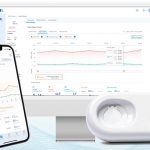
Health Tech World hears from Viz.ai following its HTW Award win in April.
Nina Binetti and Stephanie Vasquez-Mostofi talk about the importance of time in stroke care, the power of AI in connecting patients and clinical teams, and how the company’s technology could hold the key to detecting stroke before it occurs.
When it comes to stroke, every second counts.
According to research, for every minute that passes after a stroke, 1.9 million brain cells die. And as an estimated 9 per cent of all strokes slip through the net at first medical contact, the impact can be devastating.
Health Tech World 2023 award-winner, Viz.ai is on a mission to help clinical teams detect stroke before it is too late.
The digital platform uses artificial intelligence to ingest data from hospital systems, such as CT scans, echocardiograms, MRIs and electronic health records. Based on the disease area, the company has developed algorithms to detect specific conditions in medical images.
The platform does not stop at detection, however. Aiming to prevent patients from falling through the cracks, Viz connects care teams in different hospital systems, allowing critical patient images to be shared within seconds.
This quick coordination is crucial, especially in time-sensitive cases like stroke care. As this technology continues to evolve, Viz.ai envisions a future where digital platforms can go beyond early detection and eventually predict diseases before a potentially life-threatening event occurs.
Nina Binetti, vice president of product & life science marketing and Stephanie Vasquez-Mostofi director marketing at Viz.ai, speak on the company’s inspiration, the flaws in traditional approaches to stroke care and how AI could usher in a new era of preventative care.
Health Tech World: What inspired the initial development of Viz.ai’s technology?
Stephanie Vasquez-Mostofi: Dr Chris Mansi, our founder and CEO, is a neurosurgeon.
He knew that when it comes to traumatic brain injury, the deciding factor in whether a patient lives or dies is time. It can take many hours to get a patient evaluated and treated by a specialist doctor.
Dr Mansi was able to combine a passion for care with the transformational power of AI, to benefit patients who otherwise might end up severely disabled.
Stephanie Vasquez-Mostofi
Dr Mansi realised that, in order for us to have a true impact on patient care, we need to fix the workflow care coordination. That was really his inspiration for Viz.ai.
He then went to Stanford Business School and met a postdoctoral researcher in artificial intelligence who had personally suffered a stroke mimic.
Together, they conceptualised the idea of using AI as a trigger for care coordination, which led to the creation of Viz.ai.
Can you elaborate on the importance of timely stroke care and the need for platforms like Viz.ai?
Nina Binetti: Every second in stroke care is essential.
For instance, my grandmother one morning called my mother and told her she wasn’t feeling right. She was having a hard time moving her arm.
My mother said ‘No problem. I’m just going to take a shower and I’ll get the bus over there.’
My grandmother was having an ischemic stroke. But what she was saying to my mom didn’t alarm her at the time.
By the time my mother could get there and the ambulance took my grandmother to the hospital, she was paralysed on her left side for the rest of her life and she lived for 20 years like that.
That should never have happened. Times have changed but this still is happening
How does Viz.ai’s approach prevent patients from falling through the cracks?
Nina Binetti: In healthcare, patients’ conditions often go undetected or are misdiagnosed. I’m not just talking about rare diseases, these could be common diseases like heart failure or atrial fibrillation.
The other issue is patients dropping out of the system.
Maybe they have an event that drives them into the emergency room and then they are told to follow up with a different specialist but that never really happens.
We have to apply AI to help detect, notify and activate.
We can’t just leave it up to the person and the physician, or the system to get the right patient to the right doctor for the right treatment at the right time before it’s too late.
Using AI and using a platform on your mobile phone or your desktop to coordinate care really can revolutionise many different areas.
Cardiology, vascular surgery, oncology; we are trying to tackle these big areas where we can make a significant difference.
And we’re tackling some rare diseases as well.
Why did the company make stroke its initial area of focus?
Stephanie Vasquez-Mostofi: We began with a focus on stroke care not because it was easy but because it was incredibly hard.
We knew that there were so many variables in place and the team felt that if we were successful in improving patient outcomes for a catastrophic disease such as stroke, then the world was really our oyster.

After the early success in stroke, we began to look at other avenues and other areas of care coordination where there were incredibly large gaps.
We identified several vascular diseases and one in particular impacts hundreds of thousands of people annually.
So we launched into pulmonary embolism disease detection and care coordination. We also have solutions for right ventricular strain, aortic dissection and abdominal aortic aneurysm.
Those new disease states present interesting challenges and we find that in some cases, we’re actually working with similar populations of patients.
What we’re finding is that a patient may have a pulmonary embolism and then may also be at risk of cardiac disease, stroke and DVT.
All these systems are connected. By identifying that patient early and connecting them to the right care provider, this will hopefully cause a ripple effect in their care and help prevent that untimely stroke.
How does Viz.ai differentiate itself from other care coordination platforms on the market?
Stephanie Vasquez-Mostofi: The difference is the fact that we are focused on the patient journey. Other vendors are focused on the patient image.
We saw a study back in 2021 which showed that before Viz.ai, stroke patients were leaving renowned institutions in New York with a Modified Rankin Score of five which translates to being bedridden for the rest of their life and requiring 24/7 care.
The stroke was reperfused, so they were able to get the clot out, but not in time.
After the installation of Viz, the average Modified Rankin score went down from a five to a three, which translates to a patient being able to walk out of the hospital on their own with minimal help.
We’re focused on the patient journey, not just on the imaging study.
Can you give an example of how this approach might look in a real-life setting?
Stephanie Vasquez-Mostofi: We have a cryptogenic stroke care coordination platform.
One out of every four strokes have an unknown origin. Those strokes are labelled cryptogenic of unknown origin and 30 per cent of them are due to heart disease.
Viz.ai noticed this and created the opportunity to connect the neurocritical care specialist with the cardiologist and it was the first time it had ever been done.
If the origin of the stroke is unknown, the neurologist can push a button and that case is sent to the cardiologist who can review the patient’s EKG and see that the patient may need further treatment.
This is all happening while the patient is still in the hospital and receiving the care that they need.
By preventing these patients from falling through the cracks, we’re hopefully making a significant difference in patient outcomes and allowing more families to build more memories with their loved ones over the course of their life.
How do you envision this technology evolving?
Nina Binetti: I think the holy grail is to be able to image multiple parts, if not the whole body and connect it within electronic health records and look at things over time.
We all want to know what’s festering inside of us, given our genetics, given our lifestyle.
If we can know that, then patients get the care they need before these devastating things happen.

Nina Binetti
That’s going to require tech because you’ve got to be able to put images and data together. Maybe we can even marry it up with genetics and other kinds of testing and imaging.
You can think of artificial intelligence in three phases: disease detection, disease quantification and then disease prediction.
Being able to predict the stroke before it happens is truly the holy grail.
What’s in store for Viz.ai over the next 12 months?
Nina Binetti: Believe it or not, where we’re really hot and growing right now is in the pharmaceutical industry.
We have life science companies, commercial teams and medical teams engaging with us to look at ways to detect these diseases that are either not detected early enough or where patients drop out.
What’s really interesting to me is pharmaceutical employees are now [realising] that it’s not about just getting their brand or product used more.
It’s about helping the market develop so that patients can be either detected earlier or sent to the right place.
We are realising that there is loss to follow up and there is fallout where patients are missed.
I think it’s pretty exciting that we have some of the largest pharmaceutical companies in discussions with us – or already in contract with us like Bristol Myers Squibb – to develop algorithms, workflows and care coordination to help detect patients who need care.
The post Viz.ai: “Every second in stroke care is essential” appeared first on Health Tech World.





